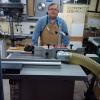Ok so I recently started a large project and could use some input on it from the shaper experts. I'm re-milling a custom t&g on something like 25,000 lf of flooring. The flooring is an "engineered core" made up of several layers of softwood about 1/2" thick. The face is end grain white oak about 3/16" thick. I have to rip the existing pieces in half lengthwise and the re-mill the cut edge into either a new tongue or groove. The job was set up by another shop who had done it previously and so I took their advice on how best to set it up. I'm running a normal corrugated 2 knife head with carbide knives. I'm using two different shapers running in the neighborhood of 6k rpm's, (one for tongue, one for groove), and feeding varies between 22 - 29 fpm as I'm trying to hone in on an ideal speed. My issue is too much chipping on the end grain. I thought this could be a problem, and it turns out it is. With the groove cut I'm only removing about 1/16" of the end grain face so have gotten about 3k lf of stock before the chipping started getting a bit iffy. However with the tongue cut I'm removing about 5/16" of face material and by about 1000 lf the chipping is problematic. At that rate I'd need to sharpen both sets of knives I have and have at least 2 more sets of knives made! I've tried slowing the speed way down to get more CPI but that doesn't seem to make a difference and will likely wear the carbide that much faster.
So I have the client coming over to look at the edges. When I picked up the order they mentioned some problems with the quality of the previous batch and that I should contact the other shop as they supposedly had a solution.... their solution was that I should sharpen the knivesSo in the meantime I want to see about possible solutions I can offer to get a cleaner edge. I'm sure the tooling they use in the factory is some obscenely expensive custom made stuff. I'm wondering about something off-the-shelf that may get me by. I know there's an awful lot of stuff out there that I don't know about.... but maybe you guys do? I'm thinking a larger diameter head with 4+ insert knives might make a difference. I'm going to call CG Schmidt tomorrow as they have a 7" diameter coping head.... maybe could have custom inserts made for it? They also have an insert flooring head, but I don't think the diameter is large enough to affect any real difference? Anything else I should look into or recommendations? Not sure yet how much the client may be willing to spend or how clean they need those edges, but I'd like to have several options to offer for when they do come by.
thanks,
JeffD




 Reply With Quote
Reply With Quote
